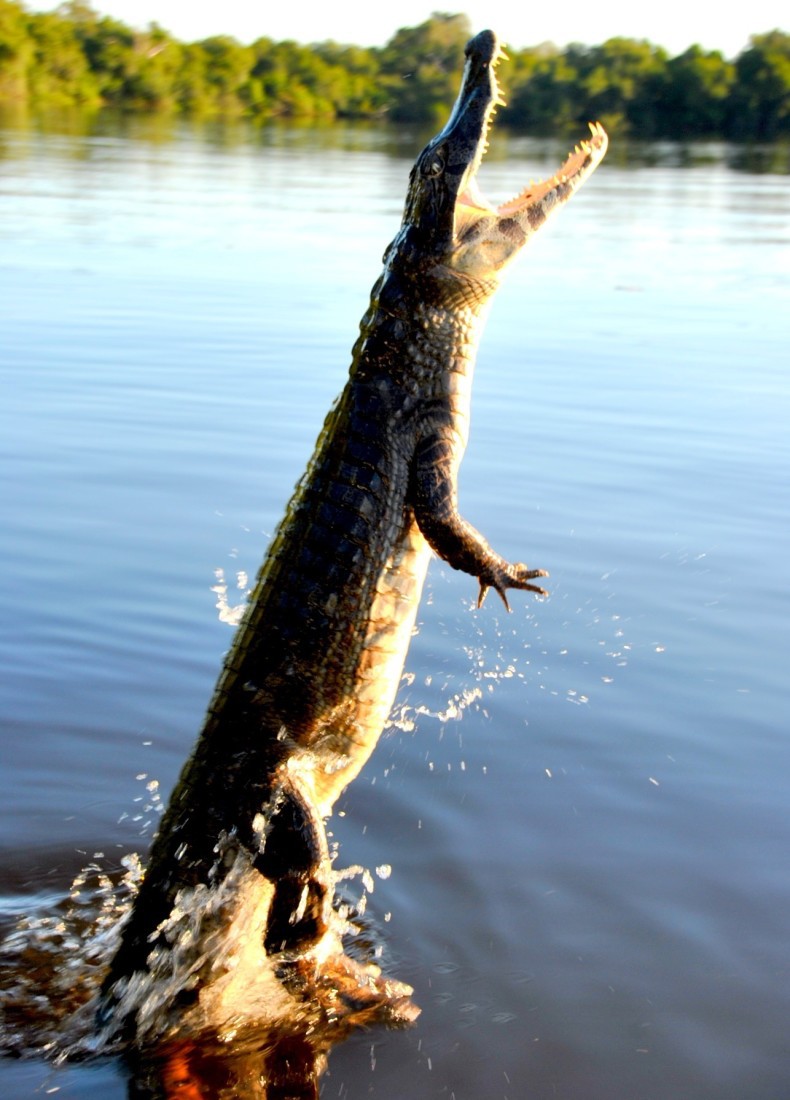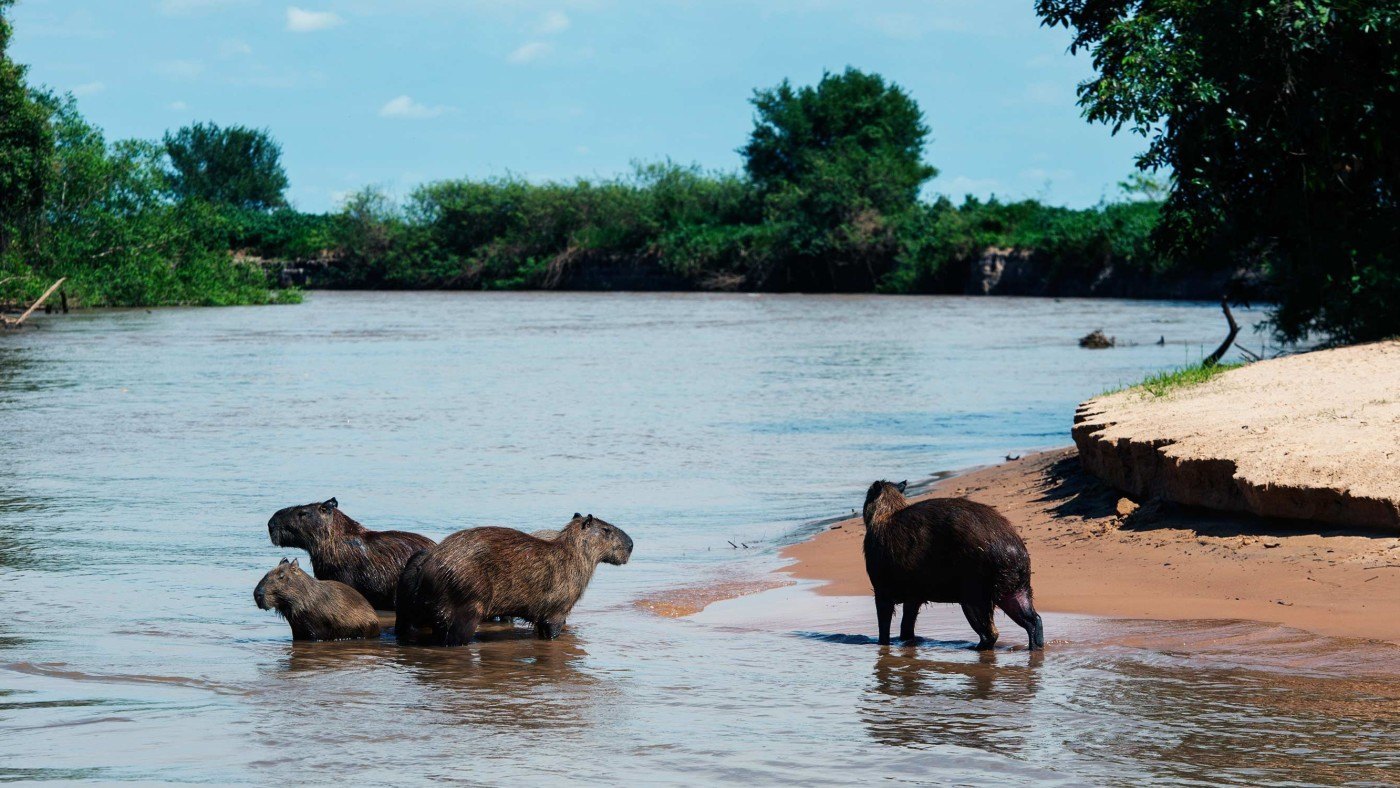“You’ll see more wildlife on the road to the Pantanal than on an entire tour in the Amazon,” my guide Igor Gaspareto tells me.
I am reassured by this. With five days to spare, and both the Amazon and Pantanal several plane journeys away, I could only choose one. I picked the less well-known Pantanal over the iconic Amazon, partly because there is no risk of malaria or zika, but mostly for the chance to see my favourite animal: the capybara. Capybaras are the world’s largest rodents, growing to the size of sheep, and look like oversized guinea pigs. They are adorable.
Igor is right: we spot a family of five capybaras before we even reach our lodge, along with emus, hawks, and the alligator-like cayman.

Cayman. Photo by Gasparetour
The Pantanal is the world’s largest tropical wetland area, and is mostly located in south-western Brazil. Essentially it is a 150,000 square km floodplain, spanning three countries. It is home to over 2000 different animal species, not counting insects, and unlike in the Amazon, visitors can expect to actually see them.
My journey begins with a flight from Rio de Janeiro to Cuiaba, a gold-rush town in the state of Mato Grosso. From there, it is a three-hour drive through Poconé and down the Transpantaneira highway. Don’t be misled by the name: this is an unpaved dirt track stretching 147 km to the state border, where it ends abruptly due to contention when the states were divided. It includes 122 bridges, many of which are little more than rickety wooden planks which shudder precariously as we drive over them.
Luckily I am in safe hands. Igor is a seasoned guide, with years of experience showing tourists everything the Pantanal has to offer. He also has an open-topped safari vehicle that can handle the constant bumps in the track and provides a high vantage point for spotting wildlife.
I tell Igor I am concerned that we are here off season – the dry season runs from May until October, and this is when the animals are easy to find around watering holes. In early April, when the ground is flooded, they are much harder to spot. He tells me not to worry. The elusive jaguars may prove difficult to trace, but there are plenty of other animals if you know how to look for them.

Cocoi Heron. Photo by Gasparetour
Igor can spot animals out of nowhere. A trailing vine becomes the tail of a spiked iguana high up in a tree. Changing dapples of light turn out to be two howler monkeys. A splash of green by the side of the road morphs into the head of a giant lizard. “That tree is where the macaw parrots live,” Igor assures me, pointing far into the distance. Sure enough, when we approach we find four gorgeous blue macaws, their long tail feathers brushing the branches below.
Eventually we make it to our lodge, Pousada Rio Claro. After such remote landscape, I am relieved to find blissfully air-conditioned rooms, and (surprisingly) even wifi. But the biggest delight is the lodge’s favourite resident, an elderly cayman known affectionately as Zico who can often be found sunbathing by the dock. The first time we head to the river, I find myself four feet away from a sprawling reptile the size of a large dog. I am almost convinced he isn’t real, until he ambles off slowly in seek of shade, leaving me standing in amazement.
Over the next three days, we explore the Pantanal by road and by river, in both a motor boat and a kayak. The temperature never drops below 35 degrees and the sunlight is blinding, but Igor is constantly alert, scanning the skies and bushes. I lose count of the animals we see: otters, herons, agoutis, marsh deer, bats, and kingfishers. A black collared hawk dives down to the river to snatch up a piranha in its talons, and at one point we are trailed by another hungry cayman.
The ‘river’ is actually a self-contained body of water, which rises by up to three metres at the height of the wet season, bursting its banks and flooding the surrounding area. One morning, we rise early to ride horses through the floodplain. The water comes up past my horse’s knees, and I realise how impassable these wetlands are. The jaguar-seekers who come in their thousands in the dry season may catch a glimpse of South America’s largest big cats, but they will miss the chance to see this landscape at its most exceptional.

The flooded Rio Claro
At night, the Pantanal is a whole other world. We go out on safari again, braving the blood-thirsty mosquitos, with Igor and the driver lighting our way with flashlights. Everything looks eerie in the colourless, two-dimensional beams. We spot another capybara family within twenty feet of the lodge, a pair of crab-eating foxes scurrying across the road, the gleaming eyes of caymans submerged in the waters reflected in the headlights.
But the real spectacle is the landscape itself, teeming with life. Nightjars and owls swoop in and out of sight and the river pulses with the croaking of frogs and the chirping of cicadas. I wonder how much we are not seeing – the ocelots I am told live nearby, the Pantanal rabbits, the 667 different bird species, not to mention the insects making their presence felt all around me.
After half an hour, Igor turns out the lights and we gaze up at more stars than any city-dweller could imagine existed. Miles away from urbanisation, we are truly in the middle of nowhere. And it is beautiful.
Igor Gaspareto is the founder of Gasparetour. He has 11 years of tourism and hospitality experience and speaks fluent English, Spanish and Japanese.
This is a three-part travel guide to Brazil. The others are Adventures in Rio de Janeiro and Falling for Iguassu.


